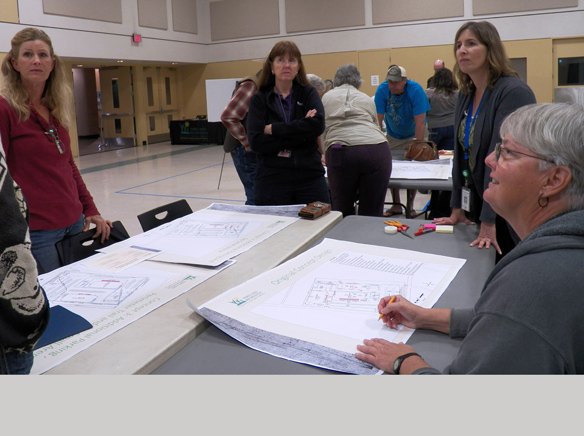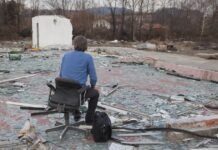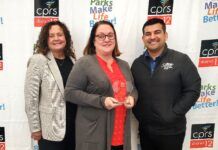Staffers with San Diego County’s Department of Parks and Recreation have in mind to develop an open parcel of land for the benefit of Lakeside residents. The project, currently in early stages of planning, is to build a new facility, especially for equestrian events and activities, adjacent to the intersection of Willow Road and Moreno Avenue.
Staffers with San Diego County’s Department of Parks and Recreation have in mind to develop an open parcel of land for the benefit of Lakeside residents. The project, currently in early stages of planning, is to build a new facility, especially for equestrian events and activities, adjacent to the intersection of Willow Road and Moreno Avenue.
Representatives of the county held a public meeting on March 10, to solicit more input from members of the community who have an interest in riding and showing horses at the new center. About 25 attendees showed up for the hands-on design workshop at the Lakeside Community Center. Participants broke into small groups around five tables, where they collaborated in adding specifics of their wished-for elements to a set of three rough “design concepts” that had been proposed and drawn, based on requested features elicited from audience members at a public meeting last month. (Betty McMillen reported on that prior gathering in her column, “Around Lakeside,” February 18, 2016).
The priority ranking of those features, as listed by the February meeting attendees, were first, for a covered arena at the facility, followed by lighting for night use, restrooms and showers, at least one uncovered arena, and a meeting space. Other requested uses were for the center to host training and clinics for riders and their horses, to be capable of staging dog events, and to have available space and amenities for overnight camping and stabling.
Scissors, glue, tape, markers, post-it notes and pencils awaited the redesign groups at each table. Consensus coalesced early among all the teams at their separate tables, over making the site elements function easily together while in use, possibly for two simultaneous and different events, and building better safety measures into their redesigns.
Compatible traffic flows for pedestrians, horseback riders, drivers and trailer parking were factored into the groups’ considerations. The redesign teams all paid close attention to the problematic nature of the nearly 14-acre parcel, which is now prone to overall flooding, and even with planned site grading would be susceptible to some rainstorm pooling at the farther reaches from the Willow-Moreno corner. Another concern addressed was shielding possibly shy horses from the noise and distractions of vehicles traversing Willow Road. The “horse show people” and the “rodeo people” sought to harmonize their differing priorities for situating the equestrian- and livestock-related features to be built at the facility.
Most of the groups supported removing a proposed small round warm-up arena and substituting use of a perimeter track for warming up horses before events. Other areas of substantial agreement were over moving the on-site shop and tack rooms to a protected location, to eliminate possible thefts of equipment, and over adding more lighting than in the existing design concepts. A couple of participants with greater familiarity with the property stated the desirability of making debris clean-up easy and installing sewer clean-outs and dump stations for facility users.
At Table No.1, Jesse MacNett, of Kovac Ranch Equipment, engaged in productive redesign planning in conversation with Michelle de Vries, president of the East County Equestrian Foundation. In a brief side interview, de Vries said that the three-year-old nonprofit she leads is likely to provide oversight of the management committee that will operate the Lakeside facility. She envisions that her current six board members will be expanded through a membership drive, with member dues going toward maintenance of the equestrian center.
MacNett later described his group’s finished redesign concept to those from the other tables, winning approval from several other teams’ members for his proposed relocation of a main arena to parallel Willow Road, so that the grandstand bleachers would lessen exposure to vehicular traffic outside the facility grounds. “Moving these around would eliminate the headache of it,” MacNett explained. He further outlined that the redesign emphasis should remain on incorporating safety factors.
A similar redesign from Table No. 2 added overnight hook-ups for campers and more parking spaces beyond the central facility elements. By contrast, Table No. 3 group members consolidated parking spaces in the center of the site, saying their focuses were on assuring safety vehicle access and creating maximum flexibility in facility use around that central parking area. This third team also moved on-site picnic tables to just outside the proposed conference room’s kitchen.
Those from Table No. 4 broke up the parking areas around the site and created a new exit on Willow Road to make leaving the equestrian center easier after an event ended. They further added more bleachers, restrooms and wash racks to the central area of the planned facility. The team from Table #5 moved the arena down to Willow Road and placed a different staging area along Moreno Avenue to aid traffic flow.
The county representatives wrapped up the meeting, noting that the intention is to make the equestrian center a successful, self-sustaining, attractive place that people will want to come to. Next in the series of public meetings will be presentation of redrawn concept designs based on the proposed features, as reconfigured at the workshop by the five redesign teams. Lakeside residents will then be invited to choose among the proposed options.














